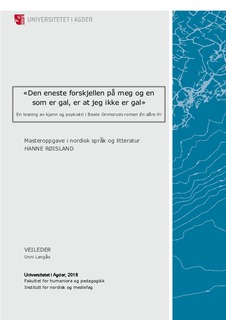| dc.description.abstract | In today’s society we experience what might be called a change of paradigm when it comes to how we regard gender. The gender binary is challenged, there are additional gender categories and the language is adjusted to this “new” reality. Sexology, together with the lgbti population, is an important contributor to this development. The novel A Fool, Free (2010, translated to English in 2015) is relevant as a retrospective comment from recent past to the need for this change. Eli, the main character, portrays a problematic upbringing and mental disorders. She is a fragile rebel trying on different masks in search for her real core. «The sculpture slumbers in the stone», she says herself. Who am I? seems to be the ongoing question in the novel. Eli hears voices and these – her alter egos – give her the opportunity to explore other personalities. Eli was assigned female at birth, but all the voices are boys. The pondering as to which gender she is, is recurring. Is she a girl or a boy? It seems to Eli there are only two possibilities. She considers «changing» her sex but she does not know to what, which indicates that she does not know from what. Eli’s gender pondering is this thesis’ main subject. The environment has never taken them seriously, and she wonders whether she herself has done so. It is striking to me how psychiatry does not tend to pay them any attention, let alone touch this essential side of her. Therefore, it is very interesting to take a closer look at what views psychiatry reveal on gender and gender identity issues in general and the connection between gender and psychiatry in the novel in particular. Both feminist literary theory and queer theory are, in addition to sexology, important driving forces for a renewed gender discourse and are thus the most important theories in my reading. The novel’s form and content give it a realistic character. Still, A Fool, Free is a novel and can per se not insist on being a representation of reality. Even so, and with these reservations, I let it represent one person’s narrative about society and psychiatry, and I comment and discuss this in a contrastive perspective with regards to the present situation. My wish is that a novel on the same subject written in a few years from now will portray gender and psychiatry’s encounter with “gender trouble” in a rather different way. | nb_NO |

